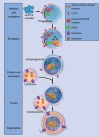Autophagy in bone homeostasis and the onset of osteoporosis
- PMID: 31666998
- PMCID: PMC6804951
- DOI: 10.1038/s41413-019-0058-7
Autophagy in bone homeostasis and the onset of osteoporosis
Erratum in
-
Correction to: Autophagy in bone homeostasis and the onset of osteoporosis.Bone Res. 2020 Oct 6;8:36. doi: 10.1038/s41413-020-00114-0. eCollection 2020. Bone Res. 2020. PMID: 33083096 Free PMC article.
Abstract
Autophagy is an evolutionarily conserved intracellular process, in which domestic cellular components are selectively digested for the recycling of nutrients and energy. This process is indispensable for cell homeostasis maintenance and stress responses. Both genetic and functional studies have demonstrated that multiple proteins involved in autophagic activities are critical to the survival, differentiation, and functioning of bone cells, including osteoblasts, osteocytes, and osteoclasts. Dysregulation at the level of autophagic activity consequently disturbs the balance between bone formation and bone resorption and mediates the onset and progression of multiple bone diseases, including osteoporosis. This review aims to introduce the topic of autophagy, summarize the understanding of its relevance in bone physiology, and discuss its role in the onset of osteoporosis and therapeutic potential.
Keywords: Bone; Osteoporosis.
© The Author(s) 2019.
Conflict of interest statement
Competing interestsThe authors declare no competing interests.
Figures







References
LinkOut - more resources
Full Text Sources
Other Literature Sources

